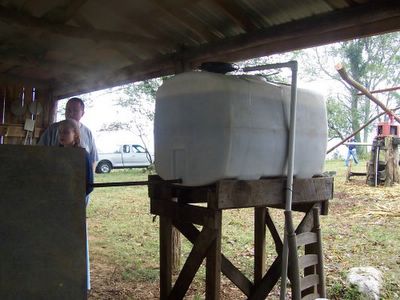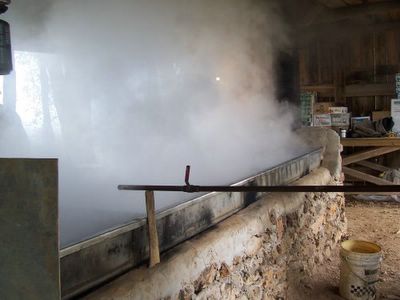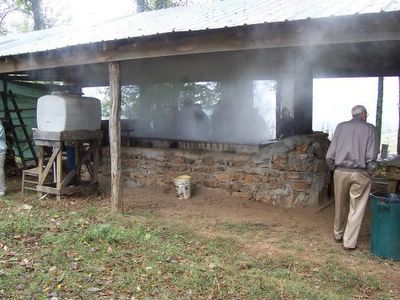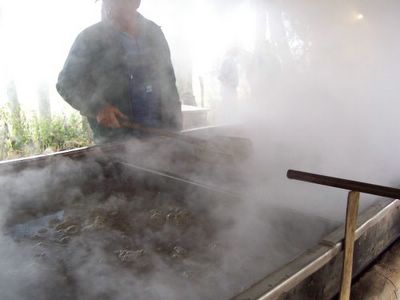Making Molasses
We had the opportunity to visit a neighboring community and observe the process of making molasses. These good folks still make 'em the old, and as I'm told, better way. They start by stripping the sorghum in the field. Next, they top it by removing the seed head. Finally, it is chopped and brought by wagon to the grinder which is driven by a mule as you can see in the photo below.

They have a pretty slick setup as you can see in the following picture. The sorghum juice runs out of the grinder, through a screen and into a PVC pipe that is buried underground. Site selection was carefully planned such that the grinder is higher than the shed allowing the 100 gal. tank to be gravity fed.

Below you can see the evaporator and the raw sorghum supply. The stainless evaporator pan used here is divided into 5 sections. The juice is cooked and reduced further as it progresses from one end of the evaporator to the other. The first 2-3 stages require constant stirring and skimming of the green foam that forms on the surface.

This day was a bit on the dreary side or there would have been a large crowd. It is still a significant social and community event. Later in the evening they were expecting some neighbors to bring instruments and play a little gospel and bluegrass.

You can just make out the skimming basket in this last picture. Although many folks participate in the operation, only one or two are qualified to man the evaporator and determine when the molasses are ready.

We tasted a bit of the local product and it was simply outstanding. Probably the best I've ever tried. For the record, the sorghum variety in this batch was "Honey Drip", one of the older and rarer varieties.
This year the harvest was particularly good and they will probably get about 50 gallons of molasses in this batch from approximately an acre of sorghum. That corresponds to 500 gallons of sorghum juice and 12-16 hours at the evaporator.

They have a pretty slick setup as you can see in the following picture. The sorghum juice runs out of the grinder, through a screen and into a PVC pipe that is buried underground. Site selection was carefully planned such that the grinder is higher than the shed allowing the 100 gal. tank to be gravity fed.

Below you can see the evaporator and the raw sorghum supply. The stainless evaporator pan used here is divided into 5 sections. The juice is cooked and reduced further as it progresses from one end of the evaporator to the other. The first 2-3 stages require constant stirring and skimming of the green foam that forms on the surface.

This day was a bit on the dreary side or there would have been a large crowd. It is still a significant social and community event. Later in the evening they were expecting some neighbors to bring instruments and play a little gospel and bluegrass.

You can just make out the skimming basket in this last picture. Although many folks participate in the operation, only one or two are qualified to man the evaporator and determine when the molasses are ready.

We tasted a bit of the local product and it was simply outstanding. Probably the best I've ever tried. For the record, the sorghum variety in this batch was "Honey Drip", one of the older and rarer varieties.
This year the harvest was particularly good and they will probably get about 50 gallons of molasses in this batch from approximately an acre of sorghum. That corresponds to 500 gallons of sorghum juice and 12-16 hours at the evaporator.

2 Comments:
This blog is downright interesting!Thanks!
Tom
That's very kind of you sir. I am daily inspired by your words of wisdom. Please continue to share.
-Keith
Post a Comment
<< Home